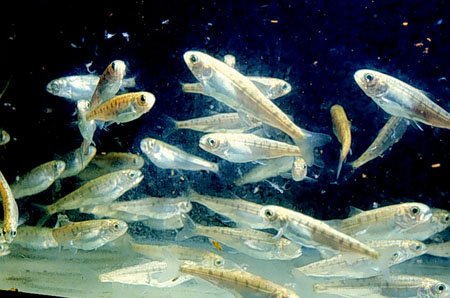|
DFG Press ReleaseDFG stocks over 1.7 million fingerling inland salmon into California lakes and reservoirsJuly 17, 2008. The Department of Fish and Game (DFG) has finished planting approximately 1.3 million fingerling kokanee and 475,200 Chinook salmon in 27 lakes and reservoirs statewide. The two- to four-inch fish were stocked into waters where natural reproduction is insufficient to provide satisfactory angling, and also to provide more diverse fishing experiences than would occur naturally. Anglers can expect excellent fishing opportunities in these waters within two years, when these fingerlings should be large enough to legally catch. Stocking fingerling-sized fish is a very cost effective way to maintain these popular recreational fisheries.
To provide and enhance recreational fishing opportunities, DFG has added Lake Isabella (Kern County) to the list of waters stocked with kokanee in 2008. Anglers can expect new fishing opportunities at this reservoir within the next few years. Monitoring and evaluating these fisheries is vital to providing a balance between the number of fish and their average size. Stocking too many fingerlings may cause the population to grow slowly and not produce quality fish. To evaluate the kokanee stocking effort at Folsom Lake, DFG biologists tagged 50,000 of this year’s kokanee allotment with coded wire tags. These fish were released in May, and will help provide valuable information to the managers of this fishery. To help us quickly spot the coded wire-tagged fish, the adipose fin was removed to allow easy identification. DFG will monitor the Folsom Lake fishery for the next several years. Anglers who fish Folsom Lake may be asked to provide information pertaining to their days’ fishing experience, including their level of effort, success and satisfaction with the fishery. Contact: Mike J. Harris, Associate Fisheries Biologist, (916) 464-6352
| ||||||||||||||||||||||||||||||||||||||||||||||||||||||||||||||||||||||||||||||||||||||||||||||||||||||||||||||||||||||
 “On behalf of DFG, I’d like to thank the volunteers of the California Inland Fisheries Foundation, Inc. and Kokanee Power, Inc. for their ongoing assistance with the Inland Salmon Program, especially during the 2007 kokanee egg take operation,” said DFG Director Donald Koch. “The careful planning and coordination between these two organizations, the American River Fish Hatchery, San Joaquin River Fish Hatchery and the Silverado Fish Planting Base have made this year’s kokanee salmon releases a huge success.”
“On behalf of DFG, I’d like to thank the volunteers of the California Inland Fisheries Foundation, Inc. and Kokanee Power, Inc. for their ongoing assistance with the Inland Salmon Program, especially during the 2007 kokanee egg take operation,” said DFG Director Donald Koch. “The careful planning and coordination between these two organizations, the American River Fish Hatchery, San Joaquin River Fish Hatchery and the Silverado Fish Planting Base have made this year’s kokanee salmon releases a huge success.”